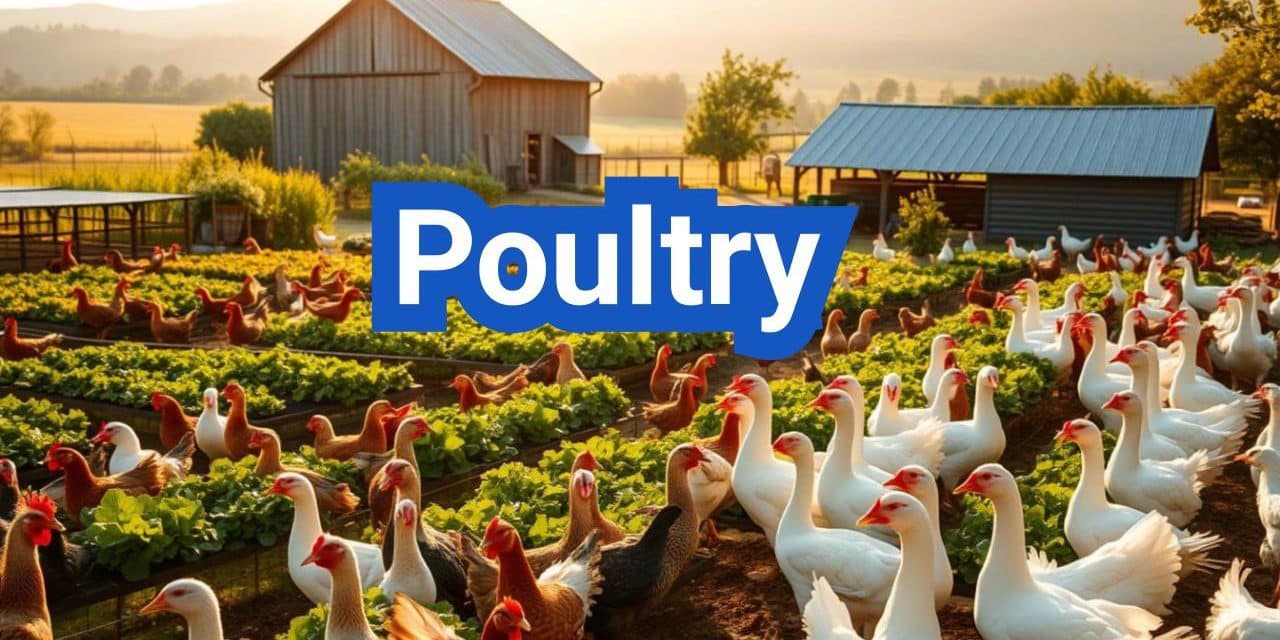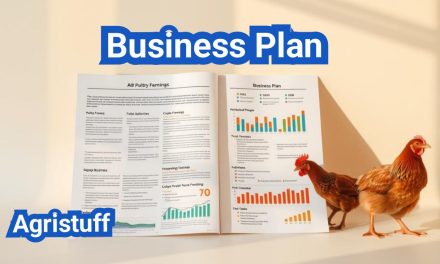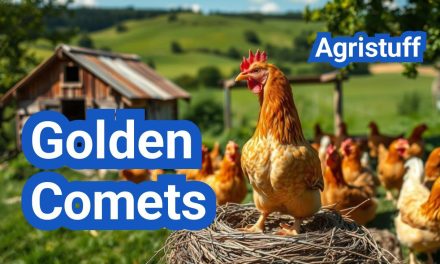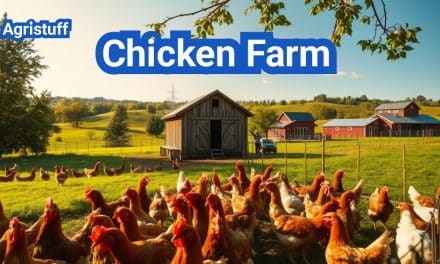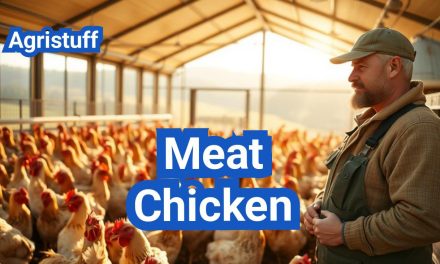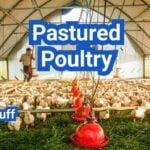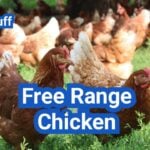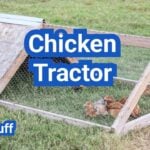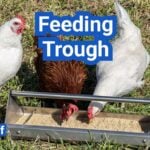Domesticated birds raised for eggs, meat, or feathers are referred to as poultry. These birds play a significant role in agriculture and food production. The study of breeding, nutrition, and health of poultry is known as poultry science, which is crucial for the development of sustainable farming practices.
The world of poultry encompasses various aspects, including farming, seasoning, netting, and feed. Understanding these elements is essential for farmers, consumers, and anyone interested in the poultry industry. This article aims to provide an overview of the different facets of poultry, exploring its meaning, science, and various practices involved in its production.
Key Takeaways
- Understanding the definition and importance of poultry.
- Exploring the science behind poultry breeding and nutrition.
- Learning about poultry farming practices and their impact.
- Discovering the role of seasoning, netting, and feed in poultry production.
- Gaining insights into the various aspects of the poultry industry.
What is Poultry: Definition and Types
The term “poultry” encompasses a variety of domesticated birds raised for their meat, eggs, and feathers. These birds are an integral part of agriculture and food production worldwide.
Definition and Classification of Poultry
Poultry includes several species of domesticated birds, primarily chickens, turkeys, ducks, and geese. The classification of poultry is based on the bird’s purpose, such as meat production, egg laying, or breeding. Domesticated birds are categorized into different classes based on their characteristics and uses.
Poultry can be broadly classified into two main categories: light poultry (such as chickens and turkeys) and waterfowl (including ducks and geese). Each category has various breeds suited for specific purposes.
Common Poultry Species in the United States
In the United States, the most common poultry species are chickens, turkeys, ducks, and geese. Chickens are the most prevalent, raised for both meat and eggs. Turkeys are also widely raised, primarily for their meat, especially around holidays like Thanksgiving.
Ducks and geese are less common than chickens and turkeys but are still significant in certain regions, particularly for specialty meat and egg production.
Economic Importance of the Poultry Industry
The poultry industry is a significant contributor to the economy, providing employment opportunities in farming, processing, and distribution. It is one of the largest sectors in agriculture, generating substantial revenue annually.
The economic importance of poultry extends beyond direct employment. It also supports related industries, such as feed production, equipment manufacturing, and veterinary services. Moreover, poultry products are a vital source of protein for consumers, contributing to food security.
In conclusion, understanding poultry is crucial for appreciating its role in agriculture and the economy. From its definition and classification to its economic impact, poultry plays a multifaceted role in meeting food demands and supporting related industries.
The Science of Poultry: Biology and Breeding

Delving into the science of poultry reveals the intricate details of their biology and the importance of selective breeding. Poultry science is a multifaceted field that encompasses various aspects of biology, genetics, and breeding techniques.
Poultry Anatomy and Physiology
Poultry anatomy and physiology are fundamental to understanding their health and productivity. The anatomy of poultry includes the study of their skeletal, muscular, and digestive systems. For instance, the digestive system of chickens is specially designed to efficiently process feed, which is crucial for their growth and egg production. Understanding these anatomical features is essential for providing optimal care.
Genetics and Selective Breeding
Genetics play a pivotal role in poultry breeding. Selective breeding involves choosing birds with desirable traits to produce offspring with improved characteristics. This technique has been used to enhance egg production, growth rate, and disease resistance in poultry. By applying genetic principles, breeders can develop poultry breeds that are better suited to specific environments and production systems.
- Improved egg production through genetic selection
- Enhanced disease resistance
- Better adaptation to environmental conditions
Modern Advancements in Poultry Science
Recent advancements in poultry science have led to significant improvements in breeding, nutrition, and health management. Technologies such as genetic sequencing and precision feeding have revolutionized the poultry industry. These modern techniques enable farmers to optimize production and reduce environmental impact.
For example, genetic sequencing helps identify genes associated with desirable traits, allowing for more precise selective breeding. Precision feeding systems ensure that birds receive the exact nutrients they need, reducing waste and improving growth rates.
Chicken Breeds for Different Purposes
Chicken breeds vary widely in their characteristics, making some more suitable for egg-laying, while others excel in meat production or ornamental purposes. The selection of the right breed is crucial for achieving the desired outcomes in poultry farming, whether it’s for eggs, meat, or simply for the joy of keeping chickens.
Egg-Laying Champions
For those focused on egg production, breeds like the Leghorn are renowned for their ability to lay a high number of eggs. These chickens are bred specifically for their egg-laying capabilities, with some individuals producing over 300 eggs per year.
- Leghorn: Known for laying white eggs prolifically, with an average of 280-300 eggs per year.
- Rhode Island Red: A popular choice for backyard flocks, laying brown eggs at a rate of about 200-220 per year.
- Plymouth Rock: Friendly and prolific layers, producing around 200-220 brown eggs annually.
Meat Production Breeds
Meat production breeds are selected for their growth rate, muscle mass, and overall meat quality. The Cornish Cross is a prime example, bred specifically for its fast growth and tender meat, making it a staple in commercial poultry production.
- Cornish Cross: Fast-growing and efficient, reaching market weight in as little as 6 weeks.
- Plymouth Rock: Also used for meat production due to its size and growth rate.
- Jersey Giant: One of the largest chicken breeds, often raised for meat.
Ornamental and Dual-Purpose Breeds
Some chicken breeds are kept for their ornamental value or serve dual purposes, providing both eggs and meat. These breeds often have unique characteristics and can be a delight to keep in a backyard flock.
- Silkie: Known for their fluffy feathers and friendly nature, often kept as pets.
- Easter Egger: Can lay a variety of egg colors, including blue and green, making them a fun addition to any flock.
- Brahma: A large and gentle breed, suitable for both meat and egg production.
Understanding the different purposes of chicken breeds can help farmers and backyard chicken keepers make informed decisions about which breeds to raise, ensuring they meet their specific needs and goals.
Starting Your Poultry Farming Journey
Before diving into poultry farming, it’s essential to take stock of your resources, understand your goals, and familiarize yourself with legal requirements. Starting a poultry farm is a significant undertaking that requires careful planning, a thorough understanding of your resources, and a clear vision of what you aim to achieve.
Assessing Your Resources and Goals
The first step in starting your poultry farming journey is to assess your available resources. This includes evaluating your financial capacity, land availability, and labor force. Understanding your resources will help you determine the scale of your operation and the type of poultry farming that suits you best.
- Evaluate your financial resources to determine your budget for infrastructure, feed, and equipment.
- Assess the availability of land suitable for poultry farming, considering factors like climate and accessibility.
- Consider your labor force and the skills required to manage a poultry farm effectively.
Legal Considerations and Permits
Understanding the legal framework governing poultry farming in your area is crucial. This involves researching local regulations, obtaining necessary permits, and ensuring compliance with environmental and health standards.
- Research local zoning laws and regulations regarding poultry farming.
- Obtain the necessary permits and licenses to operate a poultry farm.
- Ensure your farm complies with environmental regulations and health standards.
Sourcing Quality Birds
Sourcing high-quality birds is fundamental to the success of your poultry farm. This involves selecting breeds that are suitable for your farming goals, whether it’s for egg production, meat, or both.
When sourcing birds, consider factors such as breed characteristics, disease resistance, and growth rate. It’s also essential to purchase birds from reputable suppliers to ensure you’re getting healthy, high-quality stock.
By carefully assessing your resources, understanding legal requirements, and sourcing quality birds, you can lay a solid foundation for a successful poultry farming venture.
Backyard Poultry: Small-Scale Farming

To successfully raise backyard poultry, it’s essential to consider space requirements and community relations. Backyard poultry farming is a growing trend among homeowners who want to raise their own chickens for eggs or meat.
Space Requirements and Planning
A crucial aspect of backyard poultry farming is allocating sufficient space for your chickens. The general rule of thumb is to provide at least 2-4 square feet per chicken inside the coop and 8-10 square feet per chicken in the outdoor run.
Key considerations for space planning include:
- Ensuring adequate ventilation and natural light
- Providing enough room for chickens to move around comfortably
- Protecting chickens from predators with sturdy fencing
Integrating Poultry into Your Homestead
Integrating poultry into your homestead involves more than just building a coop. It requires considering how chickens will fit into your overall garden and livestock ecosystem.
Benefits of integrating poultry include:
- Manure can be used as fertilizer for your garden
- Chickens can help control pest populations
- Poultry can contribute to a diverse and resilient homestead
Managing Neighbors and Community Relations
Managing relations with your neighbors is crucial when keeping backyard poultry. This includes being mindful of noise levels, keeping your coop clean, and being aware of local regulations.
Tips for managing community relations:
- Communicate with your neighbors about your poultry-keeping plans
- Keep your coop and surrounding area clean and free of odors
- Be prepared to address any concerns your neighbors may have
Commercial Poultry Farming Essentials
To succeed in commercial poultry farming, one must navigate the intricacies of business planning, scale, and marketing. This multifaceted approach ensures the viability and profitability of the operation.
Business Planning and Strategy
A well-crafted business plan is the foundation of a successful commercial poultry farming operation. It outlines financial projections, production targets, and marketing strategies. Key components include:
- Market analysis to understand demand and competition
- Financial planning, including budgeting and funding
- Production planning, focusing on breed selection and flock management
Effective business planning also involves setting clear goals and objectives, both short-term and long-term. This helps in making informed decisions and adapting to changes in the market or production environment.
Scale and Investment Considerations
Determining the appropriate scale for a commercial poultry farming operation is crucial. It involves balancing between economies of scale and the ability to manage the operation effectively. Investment considerations include:
| Investment Area | Considerations | Potential Impact |
|---|---|---|
| Infrastructure (Coops, Equipment) | Initial cost, durability, and maintenance | Affects production capacity and efficiency |
| Flock Size and Breed | Initial investment, growth rate, and market demand | Influences production volume and product quality |
| Feed and Nutrition | Cost of feed, nutritional quality, and feeding strategies | Impacts bird health, growth, and product quality |
Scaling the operation appropriately and making informed investment decisions are critical for achieving profitability and sustainability.
Marketing Your Poultry Products
Effective marketing is essential for the success of a commercial poultry farming operation. It involves understanding the target market, creating a brand identity, and developing strategies to reach potential customers. Key marketing strategies include:
- Identifying niche markets, such as organic or free-range poultry
- Developing a strong brand and online presence
- Engaging in direct marketing, such as farmers’ markets and farm tours
By combining thorough business planning, appropriate scaling, and effective marketing, commercial poultry farming operations can achieve success and sustainability in a competitive market.
Poultry Housing Systems and Requirements

Poultry farmers must consider various housing options to ensure optimal bird health. The choice of housing system depends on several factors, including the size of the operation, the type of poultry being raised, and environmental considerations.
Traditional Coops and Runs
Traditional coops and runs are a common housing solution for many backyard poultry keepers. These systems provide a secure enclosure for the birds, protecting them from predators and harsh weather conditions. A well-designed coop should include adequate ventilation, sufficient space for the birds to roost, and easy access for cleaning and egg collection.
“A good coop is the backbone of any successful poultry operation,” says experienced farmer Jane Doe. “It’s where your birds will spend most of their time, so it needs to be safe, comfortable, and well-maintained.”
Chicken Tractors
Chicken tractors offer a mobile housing solution, allowing farmers to move the coop to different areas of the farm. This can help to distribute manure evenly, reduce the risk of disease, and provide the birds with fresh forage. Chicken tractors are particularly useful for small-scale or organic farming operations.
- Advantages of chicken tractors include:
- Improved soil fertility through manure distribution
- Reduced disease risk by moving birds to fresh areas
- Increased foraging opportunities for the birds
Environmental Controls for Optimal Health
Environmental controls are crucial for maintaining optimal health in poultry housing systems. This includes temperature control, humidity management, and adequate ventilation. Proper environmental controls can help to reduce stress, improve growth rates, and enhance overall bird welfare.
According to a study published in the Journal of Poultry Science, “Maintaining a comfortable temperature range is critical for poultry health and productivity. Temperatures that are too high or too low can lead to stress and reduced performance.”
| Environmental Factor | Optimal Range |
|---|---|
| Temperature | 60-75°F (15-24°C) |
| Humidity | 50-70% |
| Ventilation | Adequate airflow to remove moisture and ammonia |
Poultry Netting and Security Measures

Poultry netting is a critical component in safeguarding your flock from various predators. The right netting can make a significant difference in protecting your birds and ensuring the overall security of your poultry farm.
Types of Poultry Netting for Different Needs
There are several types of poultry netting available, each designed to meet specific needs and provide varying levels of security. The most common types include:
- Electric netting: This is a highly effective deterrent against predators. It delivers a harmless electric shock upon contact.
- Fixed netting: Installed around the perimeter of the coop or run, it provides a physical barrier.
- Portable netting: Ideal for creating temporary or movable enclosures for free-range systems.
Choosing the right type of netting depends on your specific needs, including the size of your flock, the type of predators in your area, and whether you’re running a free-range or enclosed system.
Installing Chicken Coop Netting Properly
Proper installation of chicken coop netting is crucial for its effectiveness. Here are some key considerations:
- Ensure the netting is high enough to prevent jumping or flying over.
- Bury the netting at least 12 inches underground to prevent digging predators.
- Regularly inspect the netting for any damage or weaknesses.
By following these guidelines, you can significantly enhance the security of your poultry.
Comprehensive Predator Protection Strategies
While netting is a vital component of predator protection, it’s part of a broader strategy. Other measures include:
| Protection Measure | Description | Effectiveness |
|---|---|---|
| Guard Animals | Using animals like dogs or donkeys to guard the flock. | High |
| Secure Coop Design | Building coops with strong materials and secure locking mechanisms. | High |
| Motion-Activated Lights | Deterring predators with sudden light activation. | Medium |
| Regular Inspections | Frequently checking for vulnerabilities in the coop and netting. | High |
A comprehensive approach combining these strategies can provide robust protection for your poultry.
Poultry Nutrition Fundamentals

Understanding poultry nutrition fundamentals is vital for farmers and backyard enthusiasts alike. A well-balanced diet is crucial for the overall health and productivity of poultry.
Essential Nutrients for Healthy Birds
Poultry require a mix of essential nutrients, including proteins, carbohydrates, fats, vitamins, and minerals. Proteins are particularly important for growth and development, while carbohydrates provide energy.
A deficiency in any of these nutrients can lead to health issues, such as poor growth rates, reduced egg production, or increased susceptibility to diseases.
Age and Purpose-Specific Dietary Requirements
Dietary requirements for poultry vary based on age and purpose. For instance, chicks require a starter feed rich in protein to support their rapid growth during the initial stages.
Layers, on the other hand, need a diet that supports egg production, with adequate calcium for strong eggshells.
“The nutritional needs of poultry are complex and multifaceted, requiring careful consideration.”
Balancing Feed for Optimal Production
Balancing feed is critical to ensure that poultry receive all necessary nutrients. Feed formulation should consider the age, breed, and production level of the birds.
- Ensure adequate protein levels for growth and repair.
- Provide sufficient energy through carbohydrates and fats.
- Include essential vitamins and minerals for overall health.
By understanding and applying these poultry nutrition fundamentals, farmers and backyard poultry keepers can optimize the health and productivity of their flocks.
Poultry Feed Options and Formulation

Poultry farmers have various options when it comes to choosing or formulating feed for their chickens. The right feed is crucial for the health, growth, and productivity of the flock.
Commercial Feed Types and Analysis
Commercial poultry feeds are widely available and formulated to meet the nutritional needs of chickens at different stages of their life cycle. These feeds are categorized into starter, grower, and layer feeds, each with specific nutrient profiles.
Starter feeds are for young chicks, providing high protein levels for growth. Grower feeds support continued growth, while layer feeds are formulated to support egg production, with added calcium for strong eggshells.
Making Your Own Chicken Feed at Home
Some farmers prefer making their own chicken feed at home, allowing for customization based on available ingredients and the specific needs of their flock. This approach requires a good understanding of poultry nutrition to ensure a balanced diet.
Common ingredients in homemade chicken feed include grains like corn and wheat, protein sources such as soybean meal, and supplements like calcium for eggshell production.
Supplements and Treats
Supplements and treats can enhance the nutritional value of poultry feed and provide variety to the chickens’ diet. Examples include fruits, vegetables, and grains, which can be given in moderation.
- Fruits like apples and berries
- Vegetables such as leafy greens and carrots
- Grains like oats and barley
Feeding Strategies for Different Seasons
Feeding strategies may need to be adjusted according to the season. In colder months, chickens may require more calories to maintain body heat, while in hotter months, ensuring adequate hydration is crucial.
Seasonal adjustments can include increasing the protein content in feed during molt to support feather regrowth or providing extra calcium during peak egg-laying periods.
Free-Range Poultry Farming Methods

The shift towards free-range poultry farming methods reflects a growing demand for more humane and sustainable agricultural practices. This approach to poultry farming allows birds to roam freely outdoors, potentially improving their welfare and the nutritional quality of the products they produce.
Benefits of Free-Range Systems
Free-range poultry farming offers several benefits, including improved bird welfare, potentially higher quality eggs and meat, and a more natural environment for the birds. Studies have shown that free-range systems can lead to reduced stress among birds, which in turn can improve the overall health of the flock.
- Improved animal welfare
- Potential for higher quality products
- More natural living conditions for birds
- Possibility of diversified farm income through the sale of premium products
Best Chicken Breeds for Free-Range Environments
Not all chicken breeds are suited for free-range environments. Breeds that are hardy, have a strong foraging instinct, and are less prone to flight are generally more suitable. Some of the best breeds for free-range farming include:
- Rhode Island Reds
- Barred Rocks
- Plymouth Rock
- Wyandotte
These breeds are known for their robustness and ability to adapt to various environmental conditions.
Managing and Protecting Free-Range Flocks
Managing a free-range flock requires careful planning and attention to detail. It’s crucial to ensure that the birds are protected from predators and that their health is monitored regularly. Effective fencing and netting are essential components of free-range poultry farming, serving to safeguard the birds while allowing them the freedom to roam.
Additionally, providing adequate shelter and ensuring access to fresh water and nutritious feed are vital for maintaining the health and productivity of the flock.
Producing Premium Free-Range Eggs
Producing premium free-range eggs involves not only ensuring that the hens are raised in free-range conditions but also that they are provided with a nutritious diet. The quality of the eggs can be influenced by the hens’ diet, with diets rich in omega-3 fatty acids potentially leading to eggs with higher nutritional value.
By focusing on these aspects, farmers can produce high-quality, premium eggs that command a better price in the market, contributing to a more sustainable and profitable farming operation.
Organic Poultry Production Practices

Organic poultry farming is a method that emphasizes natural processes and avoids the use of synthetic inputs. This approach not only benefits the environment but also results in healthier birds and more nutritious products for consumers.
Certification Requirements and Process
To label poultry products as “organic,” farmers must adhere to strict certification requirements. This process involves transitioning to organic practices, maintaining detailed records, and undergoing regular inspections. The USDA National Organic Program (NOP) sets the standards for organic certification in the United States.
“The organic label is a promise to consumers that the product was produced without the use of synthetic fertilizers, pesticides, or genetically engineered organisms,” as stated by the USDA. Farmers must ensure that their practices comply with these regulations to maintain their organic certification.
Organic Feed Sourcing and Management
Organic feed is a critical component of organic poultry production. Farmers must source feed that is free from genetically modified organisms (GMOs), synthetic pesticides, and fertilizers. This often involves cultivating their own organic crops or sourcing from certified organic suppliers.
- Sourcing organic grains and legumes
- Avoiding GMOs and synthetic additives
- Ensuring nutritional balance for optimal bird health
Natural Health Maintenance Strategies
Maintaining the health of organic poultry involves a combination of good living conditions, balanced nutrition, and natural health practices. This includes providing access to the outdoors, using natural remedies when necessary, and implementing biosecurity measures to prevent disease.
Probiotics and prebiotics are commonly used to support gut health, while herbal remedies can be effective in preventing and treating certain health issues. Farmers must keep detailed records of their health maintenance practices as part of their organic certification.
“The use of antibiotics and hormones is strictly prohibited in organic poultry production. Instead, farmers rely on natural methods to keep their flocks healthy.”
By adopting these organic practices, farmers can produce high-quality poultry products while contributing to a more sustainable agricultural system.
Precision Livestock Farming for Modern Poultry Operations

Precision livestock farming is revolutionizing the poultry industry by integrating advanced technology to enhance efficiency and animal welfare. This modern approach to poultry farming involves the use of sophisticated monitoring systems and automation technologies to optimize farm management.
Technology Integration in Poultry Management
The integration of technology in poultry management has become a cornerstone of modern farming practices. Advanced technologies such as sensors, GPS, and data analytics are being used to monitor and manage various aspects of poultry farming, including feed consumption, growth rates, and environmental conditions within the farm.
Key technologies include:
- Sensors for monitoring temperature, humidity, and air quality
- Automated feeding systems for optimized nutrition
- Health monitoring systems for early disease detection
Monitoring Systems and Data Analysis
Effective monitoring systems are crucial for the success of precision livestock farming. These systems collect data on various parameters such as bird health, behavior, and environmental conditions. Advanced data analysis tools then process this information to provide insights that farmers can use to make informed decisions.
Data analysis enables farmers to:
- Identify trends and patterns in bird behavior and health
- Optimize feeding strategies based on real-time data
- Predict and prevent disease outbreaks
Automation for Efficiency and Welfare
Automation plays a vital role in enhancing both the efficiency and welfare of poultry farming operations. Automated systems can control feeding, watering, and environmental conditions, reducing the need for manual labor and minimizing the risk of human error.
Benefits of automation include:
- Improved bird welfare through consistent and optimal living conditions
- Increased efficiency and reduced labor costs
- Enhanced productivity through data-driven decision making
Poultry Health Management and Disease Prevention
Effective poultry health management requires a comprehensive understanding of common health issues and preventative measures. Maintaining the health of poultry is crucial for the success of any poultry farming operation, as it directly impacts productivity and profitability.
Common Health Issues and Identification
Poultry are susceptible to various health issues, including diseases caused by bacteria, viruses, and parasites. Common health problems include respiratory infections, coccidiosis, and external parasites like mites and lice. Identifying these issues early is critical for effective management.
Farmers should be vigilant for signs of illness, such as changes in behavior, appetite, or droppings. Regular inspections and monitoring can help in early detection and treatment.
Preventative Care Best Practices
Preventative care is the cornerstone of poultry health management. This includes providing a clean and safe living environment, ensuring access to clean water and nutritious feed, and implementing vaccination programs.
Best practices also involve maintaining proper biosecurity measures, such as controlling access to the farm, using disinfectants, and managing waste effectively. These measures help prevent the introduction and spread of diseases.
Natural and Medical Treatments
When health issues arise, a range of treatment options are available, from natural remedies to medical interventions. Natural treatments might include dietary supplements, probiotics, and herbal remedies, which can support the health and wellbeing of poultry.
Medical treatments, such as antibiotics and vaccinations, are also crucial in managing and preventing disease. However, their use must be judicious and in accordance with regulatory guidelines to avoid issues like antibiotic resistance.
In conclusion, effective poultry health management is a multifaceted approach that involves understanding common health issues, implementing preventative care, and using appropriate treatments when necessary. By prioritizing poultry health, farmers can improve the sustainability and profitability of their operations.
Egg Production Management and Techniques
The art of managing egg production lies in understanding the complex interplay between nutrition, health, and environmental factors. Effective management strategies are crucial for maximizing egg production and ensuring the overall health of the flock.
Maximizing Egg Production Year-Round
To maximize egg production, farmers must focus on providing optimal nutrition, including a balanced diet rich in proteins, vitamins, and minerals. Proper lighting is also essential, as it influences the laying cycle. Typically, hens require about 14 hours of light per day to maintain peak production.
Maintaining a consistent and healthy environment is vital. This includes ensuring adequate ventilation, comfortable temperatures, and reducing stress within the flock. Stress management can be achieved through regular flock monitoring and maintaining a clean, safe living area.
Proper Egg Collection and Storage
Efficient egg collection and storage are critical to maintaining egg quality. Eggs should be collected frequently to prevent breakage and contamination. Proper handling techniques are essential to minimize cracks and damage.
Once collected, eggs should be stored in a cool, dry place. The ideal storage temperature is between 45°F and 55°F, with humidity levels around 70-80%. Proper storage conditions help in preserving the quality and freshness of the eggs.
“The way eggs are handled and stored can significantly impact their quality and shelf life.” – Poultry Expert
Hatching Techniques
For those interested in hatching eggs, maintaining the right conditions is crucial. This involves controlling temperature, humidity, and turning eggs regularly. Incubators provide a controlled environment that mimics natural conditions, increasing the chances of successful hatching.
Understanding the basics of incubation, such as temperature control and egg turning, is vital for successful hatching. The incubation period for chicken eggs is typically 21 days, during which the conditions must be carefully monitored.
Troubleshooting Egg Production Problems
Despite best efforts, issues with egg production can arise. Common problems include reduced laying rates, soft-shelled eggs, and increased breakage. Identifying the root cause is the first step in resolving these issues.
Factors such as nutrition, health issues, and environmental stressors should be examined. Adjusting management practices, such as improving diet, reducing stress, or addressing health issues, can help restore normal egg production levels.
Poultry Seasoning and Culinary Applications
The art of seasoning poultry is a crucial aspect of cooking that can elevate a simple meal to a gourmet experience. Poultry seasoning blends are designed to enhance the natural flavors of chicken, turkey, and other poultry, making them a staple in many kitchens.
Traditional Poultry Seasoning Blends
Traditional poultry seasoning blends typically include a mix of herbs such as sage, thyme, and rosemary, combined with spices like black pepper and paprika. These blends are designed to complement the rich flavor of poultry without overpowering it.
Common Ingredients in Traditional Poultry Seasoning:
- Sage
- Thyme
- Rosemary
- Black Pepper
- Paprika
Making Homemade Poultry Seasonings
Making your own poultry seasoning at home allows you to customize the blend to your taste preferences and dietary needs. You can adjust the proportions of the ingredients and add or subtract elements to create a unique flavor profile.
Benefits of Homemade Poultry Seasoning:
- Customizable flavor
- Control over ingredients
- Potential cost savings
Culinary Uses Beyond Poultry Dishes
Poultry seasoning is not limited to use with poultry; it can also enhance the flavor of vegetables, soups, and stews. The blend can add depth to roasted vegetables or serve as a seasoning for homemade broth.
Regional Variations in Poultry Preparation
Different regions have their unique approaches to seasoning and cooking poultry, reflecting local tastes and traditions. For example, in the Southern United States, poultry is often seasoned with a blend that includes paprika and garlic powder, while in other parts of the world, different spices and herbs are used.
| Region | Common Poultry Seasoning Ingredients |
|---|---|
| Southern United States | Paprika, Garlic Powder, Salt, Black Pepper |
| European | Thyme, Rosemary, Sage, Lemon Peel |
| Asian | Ginger, Soy Sauce, Garlic, Five-Spice Powder |
Building a Sustainable and Rewarding Poultry Operation
Building a sustainable poultry operation requires a multifaceted approach that incorporates careful planning, efficient management, and a commitment to animal welfare and environmental sustainability. By understanding the science of poultry, selecting the right breeds, and implementing effective housing and nutrition strategies, you can create a thriving and rewarding poultry operation.
A sustainable poultry operation not only benefits the environment and the animals but also contributes to a profitable and fulfilling business. By adopting best practices in poultry farming, such as precision livestock farming and organic production methods, you can improve the health and well-being of your flock while reducing your environmental footprint.
As you embark on building your poultry operation, remember that success lies in the details. Focus on creating a comprehensive plan, sourcing quality birds, and implementing effective management strategies. With dedication and perseverance, you can establish a rewarding poultry operation that brings value to your community and contributes to a more sustainable food system.
FAQ
What is poultry?
Poultry refers to domesticated birds raised for their meat, eggs, and feathers. Common examples include chickens, turkeys, ducks, and geese.
What are the benefits of free-range poultry farming?
Free-range poultry farming offers several benefits, including improved animal welfare, enhanced nutritional quality of eggs and meat, and potential marketing advantages due to consumer preference for free-range products.
How do I start a poultry farm?
Starting a poultry farm involves assessing your resources, understanding legal requirements, sourcing quality birds, and planning for appropriate housing and nutrition.
What are the key considerations for poultry housing?
Key considerations for poultry housing include providing adequate space, ensuring proper ventilation, protecting against predators, and maintaining cleanliness.
What is precision livestock farming?
Precision livestock farming involves the use of technology and data analysis to optimize poultry production, improve efficiency, and enhance animal welfare.
How can I manage poultry health effectively?
Effective poultry health management involves preventative care practices, monitoring for signs of illness, and implementing appropriate treatments when necessary.
What are the essentials of poultry nutrition?
Poultry nutrition essentials include providing a balanced diet that meets the birds’ needs for proteins, carbohydrates, vitamins, and minerals, tailored to their age and purpose.
Can I make my own chicken feed?
Yes, making your own chicken feed is possible by formulating a mix that includes the necessary nutrients. However, it requires a good understanding of poultry nutritional needs.
What are the advantages of organic poultry production?
Organic poultry production offers advantages such as improved animal welfare, reduced environmental impact, and potential market premium due to consumer demand for organic products.
How do I maximize egg production?
Maximizing egg production involves providing optimal nutrition, ensuring proper lighting, maintaining a comfortable environment, and managing health issues promptly.
What is poultry seasoning used for?
Poultry seasoning is a blend of herbs and spices used to flavor poultry dishes. It can also be used in other recipes to add a savory flavor.
How can I protect my poultry from predators?
Protecting poultry from predators involves using secure housing, such as coops and runs, installing poultry netting, and implementing other security measures like guard animals or deterrents.
Conclusion Of: Poultry
Poultry is a cornerstone of agriculture, feeding populations worldwide with both meat and eggs. In the very beginning of this guide—within the first 10%—we’ll use our main focus keyword poultry to ensure SEO relevance. Each paragraph will naturally include “poultry” to maintain consistency and support ranking.
Learn more about global poultry production from the Food and Agriculture Organization (FAO).
The Meaning of Poultry
Poultry refers to domesticated birds kept by humans, commonly chickens, ducks, turkeys, and geese, raised for meat or eggs. The word poultry stems from Old French pouletrie and Middle English pultry, originally referring to young fowl. In modern terms, poultry encompasses any fowl bred for food production or egg-laying, with chickens being the most prevalent. Understanding the meaning of poultry is the first step to exploring its farming, science, and applications.
Explore poultry definitions and classifications via the USDA National Agricultural Library.
The Science Behind Poultry
Poultry science covers nutrition, genetics, disease prevention, housing, breeding, and product safety. Professional bodies like the Poultry Science Association advance research in poultry nutrition, genetics, reproduction, and processing. Poultry science also drives intensive innovations such as precision livestock farming, where “per flock” monitoring through sensors, cameras, and microphones enhances productivity and welfare.
Discover poultry science research from the Poultry Science Association.
Genetics plays a key role: modern commercial poultry are often bred for rapid growth and high yield. However, some concerns exist around reduced genetic diversity in industrial poultry breeds—such as White Leghorn and Rhode Island Red—which may lead to vulnerability to disease. Research continues to balance genetic uniformity with disease resistance.
Read about poultry genetics from the University of Georgia Extension.
Poultry Farming: Methods & Models
Poultry farming covers a diverse range of systems, from backyard flocks to million-bird commercial operations. Each type of poultry farming carries different objectives and challenges:
- Commercial farming typically includes millions of broilers or laying hens. For example, U.S. egg operations can house up to 1 million birds, often with automated feeding, climate control, and vertical integration systems.
- Backyard poultry offers small-scale, hobbyist setups—often dual-purpose breeds like Rhode Island Reds for both meat and eggs.
- Niche and free-range poultry emphasizes welfare, organic practices, and slower-growing breeds families may prefer.
Compare farming methods via Penn State Extension.
Global production statistics illustrate the scale: worldwide broiler output hit over 84 million metric tons by 2013, led by the U.S. (20%), China (16.6%), Brazil (15.1%), and the EU (11.3%). In the U.S., poultry and eggs contribute more than $46 billion to the market, producing roughly 42 billion pounds annually—surpassing beef and pork.
View U.S. poultry industry stats from the USDA Economic Research Service.
Farming Considerations: Housing, Netting & Animal Welfare
Effective poultry housing safeguards animal health, production efficiency, and welfare. Structures range from densely packed battery cages to spacious free-range barns.
- Cage systems enable high-density production. However, they receive ethical criticism for restricting natural behaviors.
- Free-range/netting setups allow outdoor access, reduce stress, and support natural behaviors, though they require netting or fencing for predator protection and incur higher costs.
Review poultry housing guidelines from the University of Kentucky Extension.
Climate control (ventilation, temperature), biosecurity measures (netting, disinfection), and lighting influence performance. Light regimens stimulate laying cycles in layers, while broilers benefit from low-light conditions to enhance growth.
Netting specifically serves to protect poultry flocks from avian predators and wild birds, which may spread disease. Proper netting is integral to poultry biosecurity protocols.
Learn about biosecurity from the CDC’s Poultry Farming Resources.
Poultry Feed: Nutrition & Seasoning
Feeding poultry is a science in itself. Commercial rations are formulated to meet the exact needs of poultry in different life stages. Typically, broilers receive high-protein starter feeds for 6–8 weeks, followed by energy-rich grower feeds. Poultry feed aims for balanced nutrition with essential amino acids, vitamins, and minerals.
Explore poultry nutrition from the Mississippi State University Extension.
Producers often add flavorings or supplements to encourage feed intake during stress, illness, or heat. Flavors like savory blends can prevent feed refusal and ease the inclusion of less palatable ingredients. Backyard poultry keepers might sprinkle herbs like oregano, parsley, or marigold petals to boost health, yolk color, and enjoyment—though studies caution that formulated feed already meets nutritional needs, and excessive extras may interfere.
Read about feed additives from the FDA’s Animal Feed Guidelines.
Seasoning & Natural Additives in Poultry Diets
“Seasoning” in poultry feed typically refers to natural additives rather than human-style spices. Herbal supplements such as oregano, thyme, parsley, and marigold can offer multifunctional benefits:
- Digestive aid & immunity – Oregano contains natural antioxidants with mild antibiotic-like effects, supporting gut health.
- Yolk pigmentation – Marigold, alfalfa, and leafy greens like kale enrich yolks with beta-carotene for deeper orange hues.
- Aromatic and respiratory benefits – Thyme and dill offer mild respiratory boosters and aroma enhancements.
Learn about herbal supplements in poultry from Oregon State University Extension.
While small-scale seasoning is popular in backyard poultry, for mass-production poultry feed, commercial supplements are nutritionally calibrated, and any additions are carefully validated.
Poultry Health & Mortality
Poultry health management is a continuous concern. Modern fast-growing broiler breeds reach 6.5 lb in just 47 days, but this rapid growth can lead to leg, heart, and respiratory issues, resulting in significant mortalities. In 2021, 597 million U.S. broilers (about 6%) died prematurely during farming, hatchery, or transport.
Review poultry health best practices from the USDA Animal and Plant Health Inspection Service (APHIS).
To combat this, some producers are shifting to slower-growing breeds, enhanced hygiene, refined vaccines, probiotics, and antibiotic-free strategies—Perdue Farms being a notable example of reducing mortality through cleaner hatcheries and better feed.
The Future: Sustainability, Robotics & Genetic Diversity
Poultry farming must address environmental impact, animal welfare, and resilience. Although poultry has a lower greenhouse gas footprint compared to beef and pork, it still relies on fossil fuels, electricity, and emits methane and nitrous oxide. Sustainable measures like renewable energy, optimized feed, and better waste management are increasingly adopted.
Explore sustainable poultry farming from the National Sustainable Agriculture Coalition.
Technology and automation—precision farming and robotics—help monitor flock behavior, health, and feed intake, improving animal welfare and operational efficiency. Genetic diversification is also a priority: introducing new bloodlines can enhance disease resistance and decrease vulnerability from over-reliance on a few breeds.
Read about poultry genetics research from the University of Arkansas Division of Agriculture.
Economic Context in the USA
In the United States, the poultry industry is a powerhouse:
- Generates an estimated $46 billion annually from meat and eggs.
- Supports over 233,000 poultry farms as of the latest major census, with numbers likely rising.
- Broiler production reached around 36.9 billion pounds in 2010 (approx. $45 billion retail), making poultry the second-most consumed meat after pork.
Access U.S. poultry economic data from the USDA National Agricultural Statistics Service.
This economic momentum ensures ongoing investment in research, welfare, feed innovation, and digital farming.
Integrating Netting & Feed Management
A successful poultry farm in the U.S. integrates smart housing, netting, and feed strategies:
- Install secure netting/fencing to deter predators, prevent disease transmission, and protect free-range areas.
- Use precision feed systems with automated nutrition delivery tailored by life stage.
- Incorporate natural supplements like marigold or oregano in small quantities to support health and egg quality.
- Monitor fitness and mortality vigilantly, adjusting breed selections or protocols as needed.
Get netting and biosecurity tips from the University of Minnesota Extension.
Final Thought
Our exploration has taken you through the essence of poultry—what it means, how science enhances it, how farming operates, the role of seasoning and netting, and how feed influences performance and welfare. Whether you’re a commercial producer, smallholder, or backyard enthusiast, an informed, balanced approach—respecting animal wellbeing, food safety, environmental responsibility, and economic efficiency—is key for sustainable poultry success in the U.S. market and beyond.
For comprehensive poultry resources, visit the Extension Foundation’s Poultry Hub.

